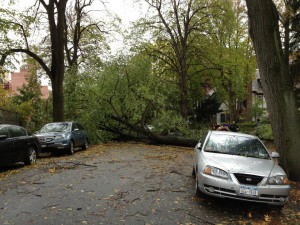The first and foremost concern for any business in the threat of and the wake of a natural disaster should be about its employees. Whatever the business, its those who serve it and its customers that are its lifeblood. Most of you know this already and surely laid out plans to ensure your employees’ safety if you were in the war path of Hurricane Sandy.
After safety and well-being is assured, we turn to the health of our business. How can we, especially retailers, ensure that a massive event like Sandy doesn’t cripple us or worse, threaten our longevity in a competitive environment? Turns out, steps toward that goal need be taken long before any such event is upon us. Companies cannot simply hope for the best, and those that know that are often those who’ve been around a while and experienced a traumatic event or two which has taught them how to prepare.
Jack Kiefer, President and Founder of BabyAge.com, learned a lot after going through 9/11. At that time, his business didn’t go down because of the disaster, despite servers being located near Canal Street, not far north from the World Trade Center site.
“You can’t take for granted,” he said. “You have to plan. We moved to a data center in Staten Island which had satellite backup and other contingencies. It’s just having a plan.”
Kiefer also had to weather Hurricane Irene last year, which hit his warehouse in Pennsylvania worse than Sandy did this year. In fact, one of the families that works for him just moved back into their house last week after nearly a year of restoration work post-Irene. These kinds of events have taught Kiefer how important it is to first ensure the safety of his staff and then ensure systems are backed up and protected.
“All our apps are hosted in the cloud but our back end inventory management system is in the warehouse [in Pennsylvania],” he said. “We purchased a backup generator in case. We had a wireless Verizon card that would have given us connectivity if we lost land lines. We wouldn’t have been able to run our business on it, but it would have given us inventory connectivity and that’s the most important thing.”
Mitch Bishop, CMO of mobile company, Moovweb, talked about the importance of having an agile ecommerce platform the wake of Hurricane Sandy or similar events. Moovweb’s clients, including companies like Macy’s and WalMart, have understood the importance of such agility.
“If the power gets shut off to your data center your business is down,” said Bishop. “A high availability ecommerce platform is critical during events like this.”
Articles have surfaced in publications like the New York Times and Huffington Post citing all of the web platforms that have gone down as a result of the storm. According to the Huffington Post, several websites stored their data at a lower Manhattan data center run by Datagram, whose basement was inundated with water during the storm, flooding generators that were intended to keep the power on. Thankfully no customers lost data according to a statement made by the firm. A New York Times article began with the compelling lede: “Here is a lesson every Web site manager may be taking away from Hurricane Sandy: It is probably not a good idea to put the backup power generators where it floods.”
Despite the risk of lost business, retailers must always be careful to remain sensitive to those who have been victim to the storm’s destruction. We can learn a lesson from American Apparel, a company whose special “Hurricane Discount,” was not well received.
Kiefer mentioned that after Hurricane Katrina, his firm donated thousands of dollars worth of merchandise to help the relief effort, but did so “under the radar.”
“It’s something we did privately and quietly,” he said.
“Maybe if we were brighter marketers, we might have found a way to do that better,” Kiefer said in jest. “But there’s a certain time when you can take advantage and other times where you should lay back.”





Recent Comments